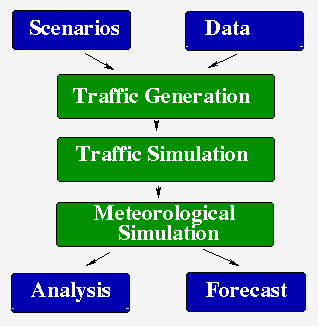
AIMS OF THE RESEARCH COOPERATIVE
Our social and economic life ist based on mobility, which means mobility of humans as well as economic goods: In 1992 more than 750 billion kilometers were travelled in West Germany. More than 81% of the resulting traffic was individual traffic, 50% of which was related to leisure activities and vacations, whereas only 33% originated from vocational and business activities. With the term mobility we associate the positive effect of being free to move wherever we want to. Apparently economic success and the amount of traffic are closely linked to one another. On the other hand mobility may have negative side effects on the quality of life: humans and nature are endangered by accidents, noise, dust, and pollutants. In important categories of pollutants traffic is more harmful than any other source of pollution, like industry or power plants. In addition a further deterioration of the current state of road traffic is no longer acceptable. Measures have to be taken that aim at:
1. reducing traffic,
2. shifting traffic to ecologically sensible transportation systems,
3. combining different transportation systems,
4. optimizing traffic.
On May 5, 1995 the Northrine-Westfalia Research Cooperative Traffic Simulation (NRW-FVU) has been established. This is a joint project, in which researchers from different disciplines of science participate to improve the understanding of traffic through interdisciplinary work. The following graphical representation is supposed to illustrate the way cooperation within the project works.

An important instrument used to understand traffic with its partly deterministic, partly random, chaotic behaviour is a microscopic simulation model, which is designed to simulate road traffic in Northrhine-Westfalia (NRW) in real time. Such a microscopic model can serve numerous purposes, the most important of which is the full simulation of scenarios. In a first step it will be shown that the model is capable of contributing to a better understanding of the ozone problem. Investigations concerning this topic will at first be restricted in such a way that only traffic on freeways and important highways will be considered.
Even this very first step requires close cooperation of very different disciplines of science: Automobile engineers have to provide data concerning the emission of pollutants, which enter the microsimulation. The appropriate amount of traffic for the simulation is generated using so-called Origin-Destination-Matrices (OD-matrices) which are calculated by town-planning engineers. Finally the data calculated in the simulation has to be passed on to a module that simulates the spreading of the pollutants from the point of view of Meteorology, where for instance the effect of irradiation with sunlight and catalysed chemical reactions have to be considered. For detailed information on the cooperation within the NRW-FVU please take a look the following graphics.
On a medium time scale the model will be expanded further. Subjects of interest are the complete simulation of complex scenarios and the integration of urban traffic into the microsimulation model.